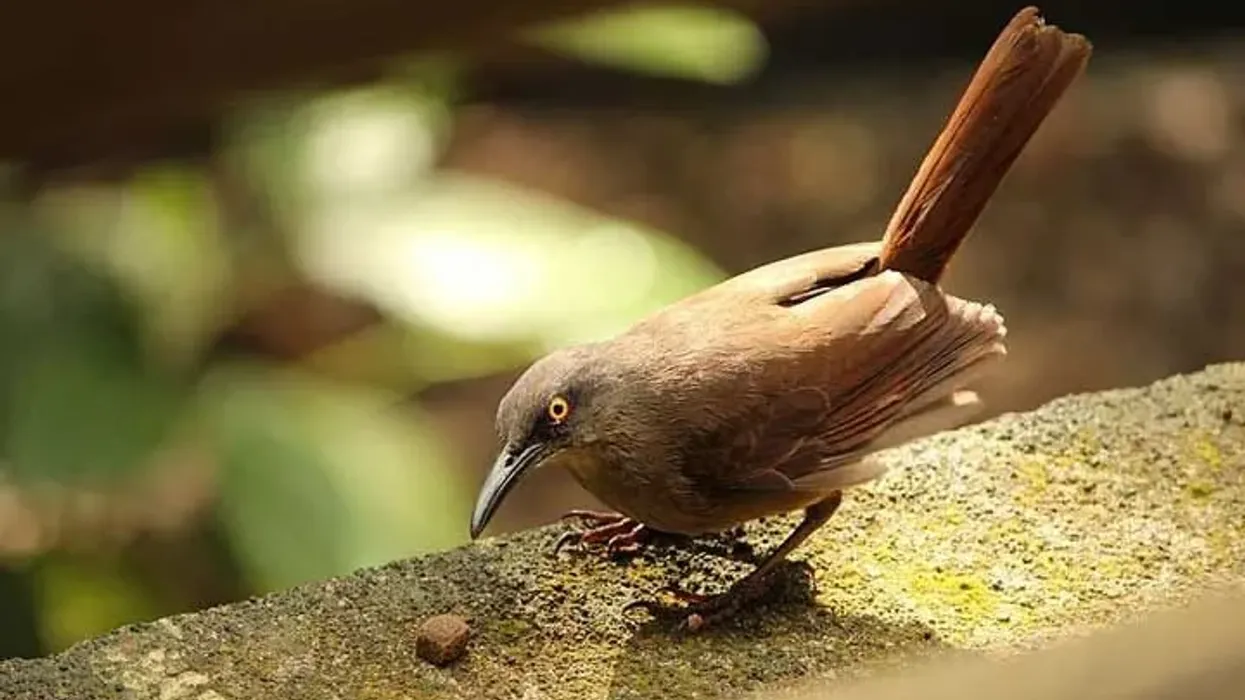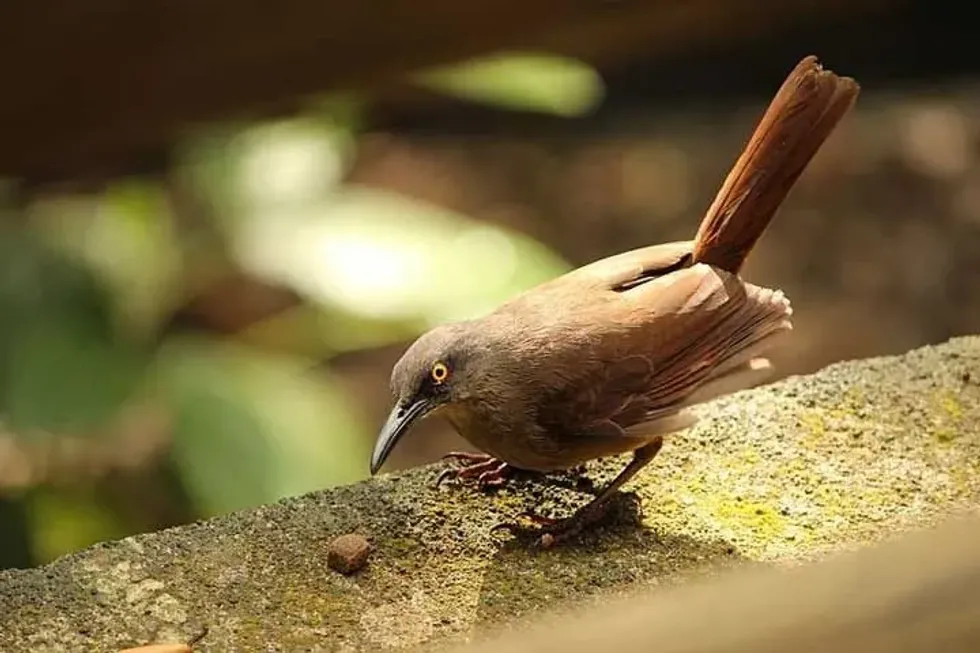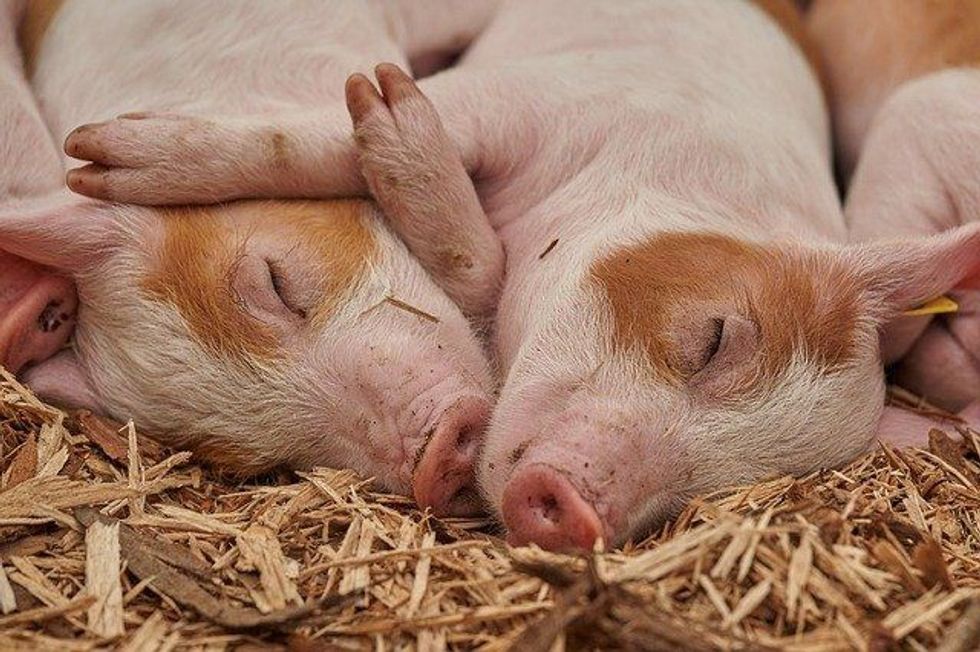Tremblers are unique birds that cock up their tails, drop their wings, and tremble their bodies, hence their name. The trembler is a large species of the Mimidae family related to New World catbirds and mockingbirds. Some northern mockingbirds also tremble their bodies like trembler.
Trembler is in close connection with Pearly-eyed thrashers. They belong to the genus Cinclocerthia and have four subspecies based on location. They are:
Brown trembler(Cinclocerthia ruficauda)endemic to lesser antilles and breeds on St. Vincent, Dominica, Guadeloupe, Montserrat, St. Kitts, Nevis and Saba. The grey trembler (Cinclocerthia gutturalis) widespread in Martinique island and Saint Lucia (St. Lucia) island. The grey trembler on St. Lucia is later considered as a subspecies, Saint Lucia trembler.
Brown tremblers and grey tremblers have the same order, family, and genus. but vary in color and considered separate species.
If you have enjoyed reading interesting facts on trembler, check our articles on other fascinating bird species like hummingbirds and bee-eaters.
Trembler Interesting Facts
What type of animal is a trembler?
A trembler is a bird species of the family Mimidae. Brown trembler (Cinclocerthia ruficauda) endemic to the Lesser Antilles and breeds on St. Vincent, Dominica, Guadeloupe, Montserrat, St. Kitts, Nevis, and Saba. Grey tremblers (Cinclocerthia gutturalis) are endemic on Martinique and Saint Lucia and are the two main species having the same order, family, genus but different coloration.
What class of animal does a trembler belong to?
A grey or brown trembler belongs to the class of Aves.
How many tremblers are there in the world?
There are four subspecies of trembler of genus Cinclocerthia. They are grey trembler (Cinclocerthia gutturalis), Saint Lucia (St. Lucia) trembler, southern brown trembler (Cinclocerthia ruficauda) northern brown trembler (Cinclocerthia ruficauda).
The population size of these species globally is unknown, but their number is stable, and they are common in their range. However, human acts like deforestation and fragmentation can affect their number in the future.
Where does a trembler live?
A grey or brown trembler lives in subtropical or moist tropical lowlands, subtropical or tropical dry forests, and highly degraded former forests.
What is a trembler habitat?
A brown trembler (Cinclocerthia ruficauda) inhabits primarily humid evergreen lowland forests and secondary plantations and forests.
A grey trembler (Cinclocerthia gutturalis) inhabits mostly wet forests, mainly islands leeward sides, and rarely occupies dry woodlands and scrublands.
Who does trembler live with?
A grey or brown trembler lives and forages in groups of around six members.
How long does a trembler live?
The lifespan of trembler birds is unknown. However, some related species of the Mimidae family are known to live for eight years.
How do they reproduce?
Less information is known about the breeding of tremblers. However, like other bird species, they may perform courtship displays. The breeding season is between March and April.
They build a cup-shaped nest using rootlets, twigs, and dead leaves. In some observations, nests are dome-shaped with side entrances. They lay a clutch of about two to three eggs that are unmarked greenish-blue.
What is their conservation status?
According to IUCN, the conservation status of tremblers is of Least Concern and is not endangered.
Trembler Fun Facts
What do tremblers look like?

Tremblers are large mimids compared to other species in the family. They can be identified by their long bills that are slightly curved and their long tails.
A brown trembler(Cinclocerthia ruficauda), as the name says, is dark brownish on the upper side and darker on tail, wings, and rump. The underparts are less brownish and have yellow iris and black bill and tarsi. Both males and females are similar regarding their plumage, but females have comparatively longer bills.
Grey trembler (Cinclocerthia gutturalis) has warm grey upperparts, darker ear-coverts, dusky-colored wings, greyish brown thighs, and flanks. And throat and breast are bluffy white. The difference between brown and grey trembles is rufous coloration and pale underparts. A young grey trembler is browner and has a mottled chest.
How cute are they?
Tremblers are attractive due to their overall chocolate brown or gray shades on different body parts and their remarkable yellow iris. They are cute to watch, especially while they tremble their bodies.
How do they communicate?
They are highly vocal and make different calls and sounds to communicate. During the breeding season, they utter loud sounds as territorial songs. The song consists of a series of loud phrases usually sound harsh and sometimes highly squeaky.
However, they may sing subsongs that are pretty musical and less squeaky that lasts for few seconds. The brown trembler's (Cinclocerthia ruficauda) standard call is a rasping nasal yeahee. They make sharp chip sound less frequently.
How big is a trembler?
A trembler is 9-10 in (23-25.5 cm) long, slightly longer than the black catbird, the smallest of the Mimidae family, nearly 8 in (24 cm) long.
How fast can a trembler fly?
It is not known how fast they can fly, they usually forage on the ground.
How much does a trembler weigh?
A male trembler weighs nearly 1.6-2.3 0z (47.6-65.4 gm) and is slightly heavier than a female that weighs nearly 1.5-2.5 oz (42.8-71 gm).
What are the male and female names of the species?
Tremblers have no specific names for males and females. They are just called male tremblers and female tremblers.
What would you call a baby trembler?
A baby trembler has no specific name but, in general, is called a chick.
What do they eat?
Gray or brown tremblers mainly consume insects and fruits. Their diet is known from the stomach content analysis made on some trembler bird species. They eat invertebrates like snails, cockroaches, spiders, and beetles, and vertebrates like frogs and lizards.
They usually forage food on the ground and sometimes on trees. They probe epiphyte clusters and tear open the vegetation using their long bill. Brown and grey tremblers are nearly similar in their diet.
Are they poisonous?
They are neither poisonous nor dangerous. In addition, they may help reduce the insect population and spread fruit seeds.
Would they make a good pet?
They are wild birds and not suitable as pets. They forage in the wild along with groups and find different nutritious food. It is always better to let wild birds free as they have their ecological importance.
Did you know...
The general meaning of trembler is a person or thing that vibrates.
Trembler also means a person whose body shakes slightly out of fear, excitement, or cold.
The scientific meaning of trembler is a bird that is named after its habit of body shaking, related to thrashers, and found in the lesser antilles.
Brown trembles were formerly found in Antigua, which is evident from the fossil history. The reason behind their extinction in Antigua may be due to changes on the island related to human colonization.
Do trembler birds migrate?
No, neither the grey trembler (Cinclocerthia gutturalis) nor the brown trembler (Cinclocerthia ruficauda) migrates and they are sedentary in their geographical location. However, they may fly short distances while foraging for food.
How did the trembler bird get its name?
These birds got their common name trembler because of their strange behavior of shaking their entire bodies in trembling motion. While singing, they cock up their tails, droop their wings, and raise them to normal position many times.
Trembling usually lasts for less than a second. The trembling frequency is different in different social contexts. They are identified as brown trembler (Cinclocerthia ruficauda) or grey trembler (Cinclocerthia gutturalis) based on the color of their plumage.
Here at Kidadl, we have carefully created lots of interesting family-friendly animal facts for everyone to discover! Learn more about some other birds from our blue jay facts and hyacinth macaw facts pages.
You can even occupy yourself at home by coloring in one of our free printable trembler coloring pages.









